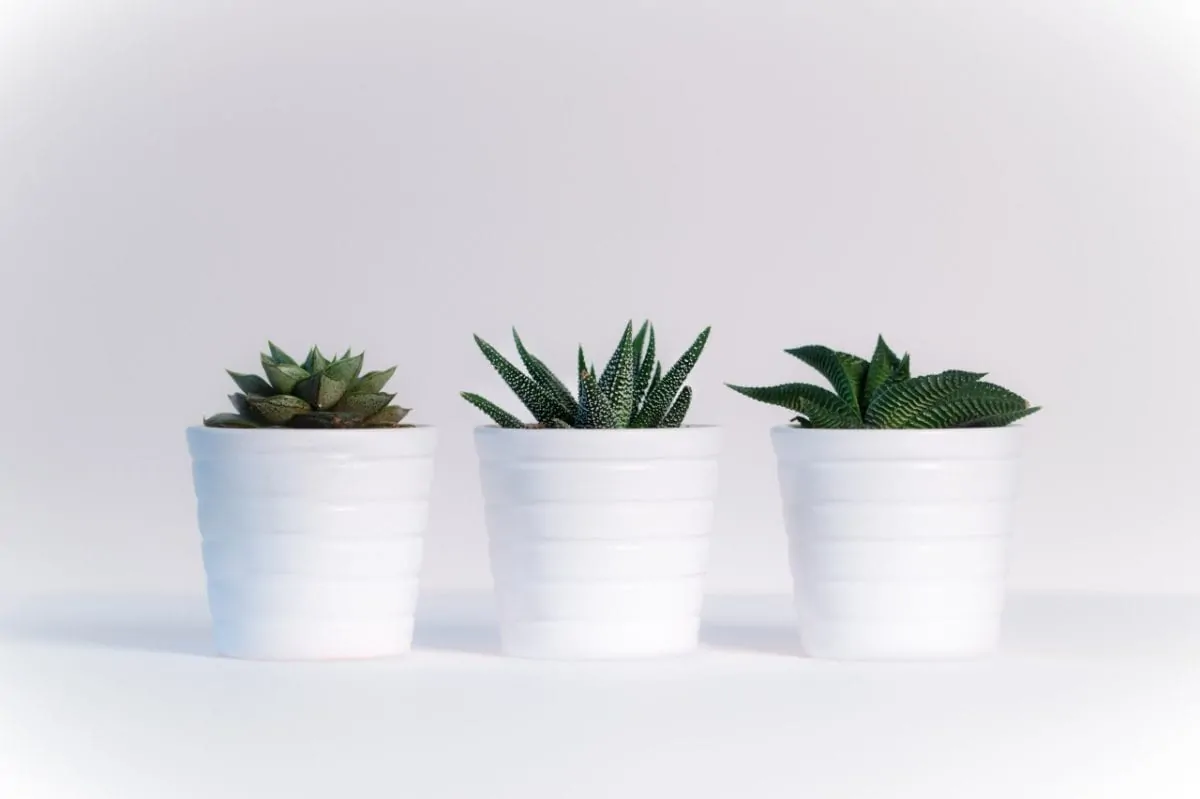

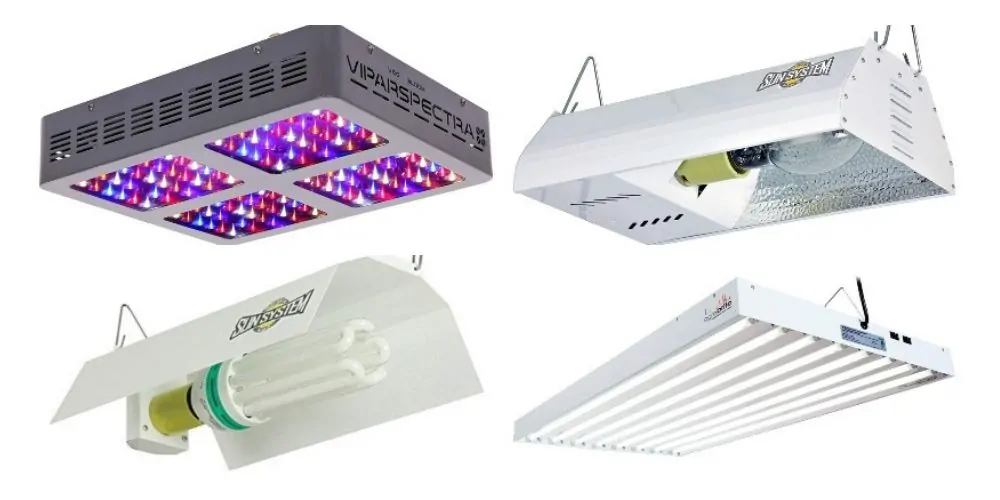
If you’ve ever grown plants indoors, you’ll know how frustrating it can be to find a spot with enough light. Many (aspiring) indoor gardeners underestimate the amount of light their plants need, especially when they’re trying to grow herbs, succulents and other light-thirsty species. Sometimes even a spot by a sunny window just doesn’t cut it and the plants grow lanky trying to reach for more. That’s where the best grow lights come in.
From a simple tropical houseplant to your fancy hydroponics system: pretty much all plants benefit from some extra lighting and will reward you with lush growth. For this reason, there are endless different types of grow lights out there.
To make choosing the right system for your plants easier, we’ll describe the most common types of grow lights below. After that, we’ll go into some of the best grow lights that we love.
Table of contents:
If you’re thinking of supplementing your indoor plants with a little extra light, you’ll have to figure out which type of grow light you’d like to go for. There are various different light types out here and all have different outputs and power usages. We’ll describe the most common and best grow lights below.
Although fluorescent lights have long been the most popular choice for growing indoor plants, light-emitting diodes (better known as LEDs!) have quickly been taking over the industry in the past few years. Although LED lights are more expensive to buy initially, they have some strong advantages over the classic fluorescent grow light bulbs and tubes. A few examples:
LED plant lights are available in all kinds of different shapes and sizes. They all consist of a panel with multiple light-emitting diodes, sometimes in certain colors to encourage a specific type of growth (flowering, foliage production, etc.).
The smallest LED lights under 5W emit up to around 300 lumens and can be used to supplement lighting for a single plant. The biggest LED panels for home use, on the other hand, can easily go over 1500W and are enough to fully light sun-loving crops from the seedling stage right up to being able to pick your own veggies and fruits!
As discussed above, fluorescent lights are quite heavily competed by LED plant lights. That doesn’t mean, however, that they are not being used any more. We definitely still appreciate CFL’s since their start price is a bit more affordable, making them attractive to those who are still figuring out their direction in indoor growing. A CFL grow light tube is a great cheap option to supplement your houseplants that are located in darker spots.
You can buy a CFL grow light that’s specifically meant for growing plants, like a nice multiple-tube T5 system that can perfectly light up a little veggie- or carnivorous plant garden. If you’re just trying to pamper your houseplants a little, though, you don’t need anything nearly that fancy. In fact, they’ll already be very happy about a single fixture with a tube that you’d normally use to light an office or other work spaces! These are simply fluorescent lights rather than compact fluorescent lights but they do the trick. The only disadvantage is simply that they’re larger.
The most important factor when figuring out which CFL grow light to buy is light temperature. Unless you’re trying to promote flowering in your plants, your best option is daylight, which is between 5000-6500K (degrees Kelvin).
HID stands for High Intensity Discharge and that’s exactly what lights of this type do. They are gas discharge lights that come in two types for plant growing: HPS and MH, short for high-pressure sodium and metal halide respectively.
All HID grow lights have high light output which means that although they have to compete with LEDs, they’re still a popular option. Due to their different light temperatures they’re used in different stages of growth or combined. HPS grow light bulbs specifically are often used to supplement light when plants also receive natural sun, like in a greenhouse.
Disclaimer: This article contains affiliate links and if you decide to buy through any of the links found here, we receive a small commission at no extra cost for you. We only suggest products we tested ourselves or products found on our wish list, nothing else. Thank you for your support!
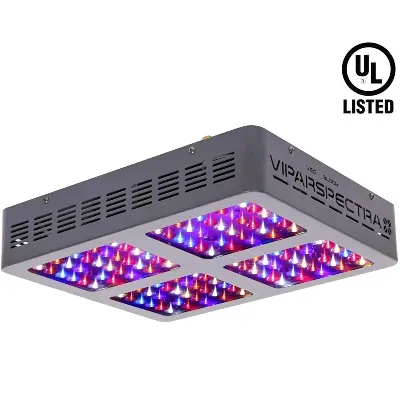
Best LED grow light
This high quality LED panel is durable, long-lived and comes with everything you look for in a light. With blue, red and white lights it’s full-spectrum and it has a veg/bloom switch to run individual light colors. This means you can optimize the light output for every stage of your plant’s life cycle.
This VIPARSPECTRA light also has a great range of wattages available, and it goes up to 1200W for those in need of some serious power. No need to buy separate fans: they’re included in the system.

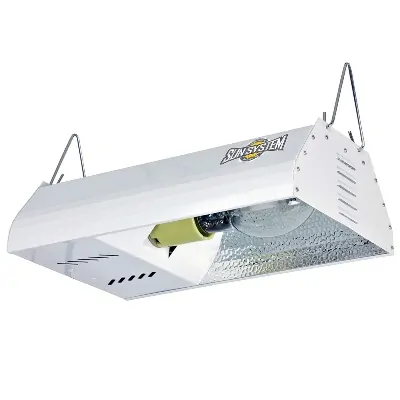
Best HID grow light
Our favorite HID grow light is the Sun System Grow Lights 150W HPS option. Although you’ll also need to get a ballast and some cooling fans as they are not included, what makes this basic system so great is that it’s easy to assemble and durable.
As the name suggests this Sun System grow light provides 150W of power, which comes down to about 16,000 lumens. Perfect for starting seedlings and providing some extra “sunshine” wherever it might be required!

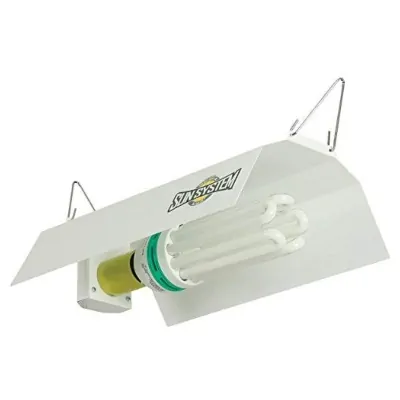
Best fluorescent grow light
Our preferred fluorescent light is a CFL by Sun System: their model 960380. This is a 125W 6500K fixture and lamp set that comes with a reflector and all of the brackets and chords you need to get started.
What we like about fluorescent lights is that they emit a pleasant white light and although they can run a bit hotter than LED, they’re nowhere near HID when it comes to heat. Reliable and high quality, it should last you long and the output is great for its tiny size.

We’ll start things off simple with a basic small set of full-spectrum LED grow lights. This nifty model consists of three goose-necked LED lamps of 10 Watts each, which can all be pointed in a different direction if need be.
The lamp features a clamp that can be used to easily clip it to any surface and combines 39 red LEDs with 21 blue ones that can be run independently or together depending on the growth phase your plant is in. The three lamps can be switched on/off independently and have six different light intensity settings. Additionally, the system contains a simple timer.
A little system like this one is among the best grow lights for those looking to pamper their indoor plants. It’s not powerful enough to use as an exclusive lighting source, but it can definitely help if your plants are struggling, especially during winter.
LED light panels are among the most popular types of grow lights nowadays. If you’d like to try one but don’t feel like shelling out big bucks or don’t have the plant collection to warrant it, this Hytekgro LED grow light panel set might be a good option for you. It contains two full spectrum 45W LED panels that you can hang above your plants. It should work perfectly for light-deprived houseplants and starting seedlings indoors.
These LED panels are full-spectrum and contain 163 red LEDs, 58 blue LEDs, and 4 white LEDs. They come with hanging kits, run cool and can cover a 3 x 3 ft planting area. Probably one of the best grow lights for those just getting their feet wet!
If the aforementioned LED grow light panel was for those who don’t want to jump into the deep end when it comes to lighting, then this King Plus panel is for those who do.
At 600, 1000 or even 1200W it’s perfect for some serious planting and can sustain various types of plants throughout their entire life cycle rather than just the seedling stage. This makes them a great choice for those who would like to grow vegetables and fruits indoors with no natural light.
These LED grow lights provide full-spectrum light and have a veg/bloom switch so you can optimize the lighting for the different stages of a plant’s life cycle. The panel includes quiet fans to keep the temperature in check. Because LED panels this powerful can damage the eyes it comes with a pair of protective glasses and the set also includes a hanging kit.
The next high-wattage LED panel, this Phlizon model is another good choice for growing fruits, veggies, and other light-loving plants indoors with no additional lighting. It produces full-spectrum lighting with a mix of red, blue, UV and infrared and has veg/bloom switches to optimize the lighting.
The 600W Phlizon Newest model can cover a 2 x 2 ft area despite lacking a reflector (which decreases the chance of temperature issues), while the more powerful versions work well for larger footprints. To further keep the temperature down and protect both the light itself and your plants, the panel contains double cooling fans. A thermometer is included so you can keep an eye on the temperature, and the kit also comes with the materials needed to hang it.
The first high-pressure sodium light on the list, this 150W Sun System system delivers 16,000 lumens. It makes a great option for those who are not into LED but still need indoor grow lights to provide extra brightness for their houseplants or seedlings.
The set includes an HPS bulb and a reflective insert, although you’ll also need a ballast to run it. It also lacks air cooling, so if you’ll be using it in a confined space or want to place it close to your plants you might need to look into some extra fans. After all, HPS grow light bulbs do run hot!
Another HPS light, this one packs a bit more of a punch at 400-1000W. Unlike the previously mentioned light, this kit from iPower includes not only a reflector, light, power cord and hanging system but also a dimmable digital ballast (which can be set to 50%, 75% or 100% and is more efficient than the traditional magnetic ballast in terms of output).
Just add some fans to the mix if you’re using this indoor grow light in an enclosed environment like a grow tent and you’ll be ready to go!
Another three-headed, goose-necked mini LED grow light system, the difference between this one and the similar system mentioned earlier is that we’ve got double the power on our hands here (60W divided into three lamps rather than 30W). It contains 39 red and 21 blue LEDs to ensure your plants get what they need; you can switch between these colors or turn them all on at once depending on your needs.
These grow lights for indoor plants can be dimmed to anywhere between 20-100% output and feature a clamp for easy mounting. They can also be programmed to turn off after 3, 6 or 12 hours. Although these LEDs are not very powerful and can’t sustain any plants on their own, any houseplants or herbs you grow will greatly appreciate this little boost during wintertime.
Since it’s available at 300, 600, 900 and 1200 Watt, there’s a VIPARSPECTRA LED light panel for every kind of plant grower. All of these panels come with the same full-spectrum output and although they are a bit more pricey than similar LED grow light panels on this list, they more than make up for the (small) difference.
These indoor plant lights come with a veg/bloom switch to adjust the lighting based on your plants’ needs and include a cooling system to prevent scorching as well as a fire-resistant reflector. Another very handy feature is that they’re daisy-chainable: you can connect two of them together and plug them into the same socket to avoid a mess of cables.
At up to 40,000 lumen output, the eight 4-foot tubes included in the Agrobrite FLT48 fluorescent system pack enough of a punch to seriously pamper any houseplants, grow herbs or get veggies through the delicate seedling stage. The 6400K light temperature is pleasant for us humans to look at since it’s white rather than LED’s harsh purple.
Keep in mind that since fluorescent grow light bulbs are less efficient than LEDs, they can run a bit hotter. That being said, some simple fans should help avoid any issues with this tube system!
If a normal fluorescent system like the previously mentioned FLT48 by Hydrofarm is a bit too large for you to run, CFL is the way to go. These grow lights for indoor plants, like this 960380 by Sun System, are smaller than traditional fluorescents but still have great output. This particular model comes with everything included, including a wing reflector, 125 Watt/6500K bulb, mounting bracket, and power cord.
A little CFL like this one is the perfect solution if you’ve got a small (2 x 2 ft) growing area to cover and don’t need a large light. Ideal for starting seedlings and maybe even growing herbs indoors year-round! Do keep in mind that, again, fluorescent lamps run a bit hotter than LED. If you’re using this in an enclosed space, some ventilation is probably a good idea.
No matter what you’re growing, all plants will appreciate some extra light. Using indoor plant lights allows you to grow your own produce indoors year-round rather than having to wait until spring. Even if you do like growing outdoors, how convenient is it to get to start your seeds early for a longer season?! Extra lighting also allows you to grow houseplants in dark corners without windows and can even brighten your own mood if you’re suffering from the winter blues.
Whether you end up going for LED, High-Intensity Discharge or fluorescent all depends on your own preferences when it comes to growing plants. Every grow light type has its own pros and cons and a lot of it depends on your eventual goals. In any case, this list covered suitable lights for everything you can think of that might require a bit more brightness: tropical plants, succulents/cacti, carnivorous plants, herbs, seedlings, leafy greens, vegetables, and fruits.
There’s a grow light for everyone, so get growing!

Monthly updates on your favorite plants and how to keep them alive, delivered straight to your inbox!
Privacy Policy
This privacy policy outlines what info we gather from our visitors and contributors, the tools we use to collect, store, and protect it, and how we use this information.
Like any other website on the World Wide Web, YouHadMeAtGardening.com records some info about you and your device during your visit. This privacy policy outlines how our team gathers, stores, protects, and uses the information it gathers from visitors of the YouHadMeAtGardening.com website.
By continuing to use this website, you implicitly agree to this policy; if you do not agree to some or all of the procedures listed on this page, you can opt out at any time, however, you might not enjoy the intended browsing experience.
Our team reserves the right to alter this privacy policy with no prior notice to you. However, if the alterations made affect your personal data in any way, you will be notified immediately by email, on our homepage, or here.
Information YouHadMeAtGardening.com Collects
Our systems gather personally and non-personally identifiable information from visitors of the YouHadMeAtGardening.com website.
The only personally identifiable information we collect is your name and e-mail address only when leaving comments if you’re a visitor, or when submitting content and leaving comments, if you’re a contributor.
However, if you are not comfortable with providing your personally identifiable information to us, you can also use an alias instead of your real name and e-mail address without breaking any rules or regulations currently in use.
Note: If you submitted a comment using your personally-identifiable information and want it removed, you can always contact us and we will remove your info in 30 days.
The non-personally identifiable information we collect is your IP address, ISP information, device and browser info, and your browsing patterns – specifically the pages and websites you visit. This information cannot be used to track down your identity.
How We Collect Your Information
We use the following tools to gather personally and non-personally identifiable information from visitors and contributors:
• Cookies: these tiny text documents contain unique identifiers that are stored in your computer after your expressed consent. Cookies collect non-personally-identifiable information about your browsing patterns, which helps us pinpoint the areas of our website that require extra work and the areas that fully meet your needs.
• Log files: These tools record browser and device information, browsing patterns, websites that referred you to the YouHadMeAtGardening.com website, pages our website referred you to, and other types of non-personally identifiable information.
• Sign-up forms: these requests only come up when registering for our newsletter and is the only way our team collects personally-identifiable information from visitors.
How We Protect Your Information
All information we gather, both personally and non-personally identifiable, is stored in systems and databases managed only by the YouHadMeAtGardening.com team. We use the latest security measures to make sure the information you provide and the information we gather stays confidential, such as encryption, user behavior monitoring, and a series of managerial procedures.
How We Use Your Information
We only use your personally and non-personally identifiable information to improve the quality of the website and your browsing experience while here. We want to know which pages and sections of our website satisfy your needs and are of real value to you and which ones need improvement so we can make the proper adjustments. We also use your information to make sure the website is properly displayed on your device and browser.
If you choose to opt in for our newsletter, we will also use your information to keep in touch.
However, know that the YouHadMeAtGardening.com team will never share your information with other parties in exchange for financial rewards or any other kind of benefits. Some third parties might get very limited access to your info, but only to your non-personally identifiable information and only as we described above.
The personally identifiable information you provide is strictly confidential, therefore we will not share it with anyone.
Advertising
This Site is affiliated with CMI Marketing, Inc., d/b/a CafeMedia (“CafeMedia”) for the purposes of placing advertising on the Site, and CafeMedia will collect and use certain data for advertising purposes. To learn more about CafeMedia’s data usage, click here: www.cafemedia.com/publisher-advertising-privacy-policy

Great review! I was specifically looking for an affordable LED light panel. Thanks for the recommendations!